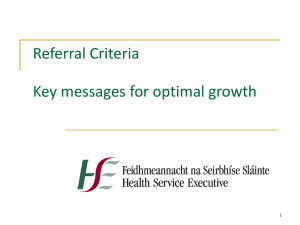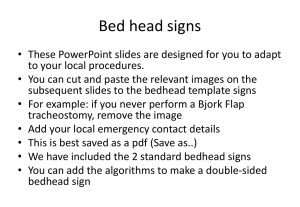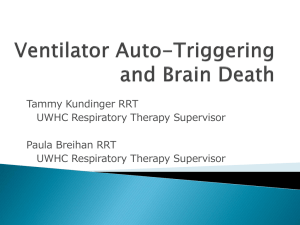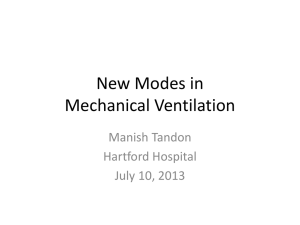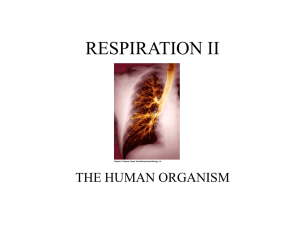Mechanical Ventilation Weaning Protocol
advertisement
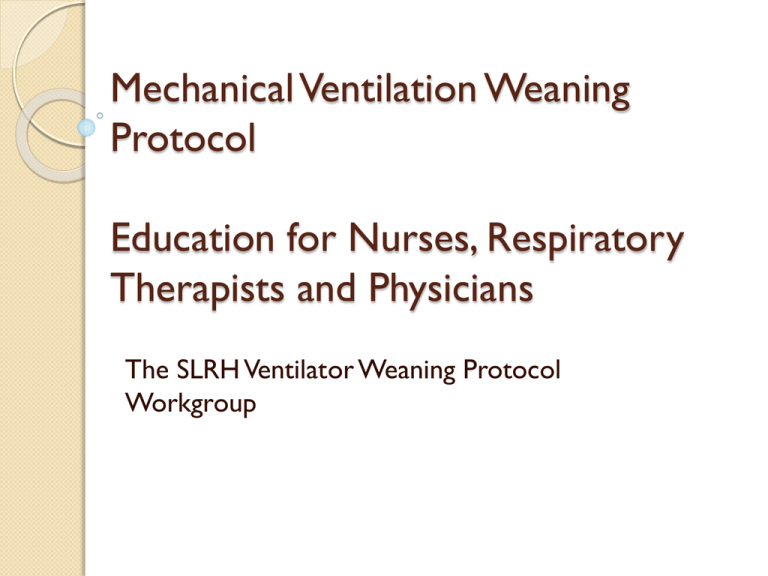
Mechanical Ventilation Weaning Protocol Education for Nurses, Respiratory Therapists and Physicians The SLRH Ventilator Weaning Protocol Workgroup Objectives of this program Provide education about ventilator weaning in the Critical Care Units and Medical Progressive Care and Step down Units Provide rationale and benefits for using a ventilator weaning protocol Review the assessment tool for ventilator weaning in critically ill patients Review SLRH vent weaning protocol: ◦ Revised acute vent weaning protocol ◦ New chronic vent weaning protocol Explain tracheostomy decisions and care Demonstrate how weaning is integrated into the total care of the patient A Weaning Protocol: Promotes a standardized assessment of each patient’s readiness to wean as part of the daily assessment by the nurse and respiratory therapist Empowers the nurse and respiratory therapist to initiate the process of early weaning from the ventilator by identifying patients who are ready Facilitates collaboration between the RN/RT and physician or nurse practitioner The Physician can order the weaning protocol based on the assessment by the RN/RT and MD/DO Benefits of a Weaning Protocol Studies have shown that weaning protocols lead to a DECREASE IN: ◦ ◦ ◦ ◦ Duration of mechanical ventilation ICU and hospital length of stay Number of tracheostomies performed Complications associated with mechanical ventilation Ventilator-associated pneumonia and lung injury Venous thromboembolic disease Gastrointestinal hemorrhage Improving weaning from mechanical ventilation Early morning daily awakening and daily spontaneous breathing trial decrease duration of mechanical ventilation Both nurse-driven and respiratory therapistdriven weaning protocols lead to earlier weaning and extubation, compared to physician-driven protocols Wesley,E et al; N Engl J Med 1996; 335:1864-1869 Kollef,Marin et al;Crit Care Med 1997; 25:567-574 Why do we need a weaning protocol in our critical care units? Weaning Protocols are the Standard of Care in Intensive Care Units We can REDUCE: ◦ Duration of mechanical ventilation ◦ ICU and hospital length of stay ◦ ICU and hospital mortality ◦ Sedation ◦ ICU complications such as ventilator-associated pneumonia (VAP), ventilator-associated lung injury venous thromboembolism and GI hemorrhage ◦ Neuromuscular dysfunction, delirium, and cognitive dysfunction ◦ Weakness due to delay in mobilization We need to standardize our goals and management of mechanically ventilated patients in order to provide the best care for our patients. W.E.A.N.! at SLRH Work together – RN, RT, NP, PA, MD/DO Early identification – Early in the day, early in the course Assessment by RN and RT in daily screen and protocol Notify physician to start protocol and how patient tolerates weaning Weaning: working together - clinicians and patients The ICU and stepdown nurse and the respiratory therapist for the patient have the important role of timely assessment of weaning readiness The Physician needs to make the overall decision about whether the patient should undergo the weaning protocol There are different ways of weaning and this process is individualized. So different modes of weaning may be chosen based on the patient’s disease and course. Weaning protocols in different units Our protocols will take into account the resources of the different units – critical care and stepdown units - so that the presence and support of nursing and respiratory care are optimal. In addition to the early morning protocol, weaning assessment can be done at any time during the day. Acute and Chronic Weaning What is the difference? Acute generally refers to patients with an endotracheal tube who have been on the ventilator for less than 2-3 weeks Chronic generally refers to patients who have been on the ventilator for longer periods and who have a tracheostomy ◦ Patients with a tracheostomy may require a more prolonged process ◦ However, even some patients with a tracheostomy may be weaned in a short period of time The weaning protocols The protocols are found on Forms on Demand We will go through the steps of the protocols for acute and chronic weaning Step 1: Assessment for Weaning Readiness Initial assessment is the “screening” based on patient factors, ventilator factors and sometimes ABG. This is the daily screening to be done by the RN and RT to see if the patient is ready for a weaning trial. This screening does not involve any ventilator changes. Screening facilitates early morning weaning trial and extubation and does not have to wait for physician rounds This assessment ties in with the sedation policy: using the sedation protocol to achieve a RASS of 0 or a daily interruption of sedation is appropriate for weaning patients Early assessment for weaning The screening is done in the ICU daily by the night shift (between 5:30 and 7 am) so that, if the patient passes, weaning can be started early ◦ Document readiness on ICU flowsheet If a barrier is found, such as the patient is too sedated, this is the opportunity to reduce/stop sedatives to achieve the RASS goal and score ◦ The screening can be repeated at any point if the condition changes STEP 1: Assessment for weaning readiness The patient meets the following criteria: PATIENT FACTORS □ Hemodynamically stabilizing: □ Vital signs acceptable ( BP ≥ 90 systolic, HR ≈ 55 to 135 bpm) □ Tapering/low doses of vasopressors □ Sp02 > 92% □ Can follow simple commands □ Adequate cough on command □ Initiate good inspiratory effort □ Patient is not expected to follow commands VENTILATOR PARAMETERS □ FiO2 < 50% □ PEEP ≤ 5 cm H20 ABG PARAMETERS □ PaO2 ≥ 75 mmHg □ pH > 7.25 STEP 2: Criteria met, Notify Physician for initiation of protocol RN and RT communicate the weaning readiness with the MD/DO ( fellow/housestaff/attending) Physician decides whether weaning should be initiated. Some situations in which the patient meets criteria but weaning will not be done include – procedure or test that will require ventilation, concerning lab test or change in stability. Physician decides on the vent weaning mode, completes orders and places order in Prism to initiate weaning protocol Feedings held Sedation goal RASS of 0 achieved or hold sedation Explain to the patient Physician Order for Weaning The MD/NP needs to place the order for weaning only once This order will remain active for daily weaning unless cancelled due to change in patient condition Please note… There are some patients who have a neurologic injury or baseline dysfunction – who are not expected to follow commands, but who still may be able to wean from the ventilator. The clinicians may decide to proceed with a trial of weaning in patients who do not pass all readiness criteria. Start weaning protocol early Between 5:30 and 7 am in the ICUs By 9 am for chronically-ventilated patients in the stepdown units STEP 3: Method of weaning chosen by physician SPONTANEOUS BREATHING TRIAL METHOD (SBT) □ PS=____ □ CPAP = ___ □ FI02 ___% □ T-piece □ Duration ___minutes □ ABG needed ( )Y( ) N GOAL : ____ min SIMV METHOD □ Set IMV___ PS___ □ FiO2___% □ Decrease IMV rate by __ q __ h □ Decrease PS by ___ q ___ h □ ABG needed ( ) Y ( ) N GOAL: IMV ≤ 4 AND PS ≤ 8 for ___min PRESSURE SUPPORT VENTILATION METHOD (PSV) □ Set PS___ □ FiO2___ % □ Decrease PS by ___q ___h □ ABG ( ) Y ( ) N GOAL : PS ≤ 5 for ____ min SICU METHOD □ CPAP = 5, PS=0 □ FI02 21% □ Tolerates 20 min □ Then ABG: GOAL: Pa02 >50mmHg PaC02 <50 mmHg RR < 35/min Acute weaning – Spontaneous Breathing Trial “SBT” The most common method is the SBT: CPAP mode, pressure support 5-8 cm H20. Duration 30-120 minutes. Other methods include: ◦ SIMV with gradual reduction in respiratory rate ◦ Pressure support with gradual reduction in amount of pressure support For SICU patients, CPAP trial for 20 min Physician Order: must complete method, settings, and duration STEP 4: Assessing patient tolerance of weaning •Respiratory Rate <35 breaths per minute •Heart rate between 50 and 130 bpm and within ± 20% of pre-trial HR •Systolic Blood Pressure (SBP) between 90-170 mmHg and within ± 20% of pre-trial SBP •Exhaled TV ≥ 5 cc/ kg IBW ( ≈ 300 – 400 ml ) •SpO2 ≥ 92 % •Patient showing no diaphoresis, paradoxical respiration, retractions, nasal flaring, agitation, or complaining of SOB, or use of accessory muscles •Serial assessments of tolerance are made 5,15,30,60,and 120 minutes after the INITIAL setting and following any subsequent ventilator changes. STEP 5:Tolerating weaning trial – success! Notify physician and team Arterial blood gas, if ordered Physician informed about the successful weaning RT - set up for extubation Physician will be present for extubation The patient is monitored following extubation: ◦ In addition to vital signs including Sp02 ,always check for stridor, breath sounds, secretions Not tolerating weaning today… If not tolerating weaning go to pre-trial settings Document on Weaning Flow record – in what way the patient did not tolerate weaning, duration of weaning, level of support used This will improve our communication and plan for the next weaning trial so that we can move forward with weaning the patient Documentation The daily outcome will be written in the weaning flow record which will be kept in the Respiratory Care book. The RN and RT document the progress The medical, nursing and respiratory staff will view the flow record in making further decisions about weaning Vital signs, ventilator settings, extubation are charted in the ICU flow record as usual Weaning Flow Sheet Documentation Chronic Vent Weaning This protocol applies to patients with tracheostomies who are undergoing weaning in the Critical Care Units, MPCU, stepdown vent units RH 10B, SL 10E The early assessment is the same Screening by nurse or respiratory therapist for readiness ◦ Document in nursing/respiratory notes or ICU flow record Only one order to wean is needed and will apply until the order is discontinued Weaning will be started by 9 am daily Methods of Chronic Vent Weaning Some patients who have been on a ventilator for a prolonged period or have a tracheostomy may need a more progressive program for weaning The two general methods are: ◦ Pressure support PS– gradually decrease the PS amount and prolong the time ◦ Trach collar – use trach mask for progressively longer periods of time ◦ Other methods such as volume support may also be used Chronic Weaning Documentation The duration of weaning is documented on the flow record. This will be kept in the respiratory folder. The RN or RT may document the progress The medical, nursing and respiratory staff will view the flow record for further decisions about weaning Tracheostomy: Indications Prolonged ventilator requirement and inability to wean due to ◦ Generalized weakness, such as critical illness polyneuropathy ◦ Multiple comorbid conditions that require prolonged ventilation ◦ Chronic critical illness Inability to clear secretions Severe neurologic dysfunction Airway obstruction ◦ Tumor, upper airway injury, edema ◦ Severe obstructive sleep apnea with complications, not amenable to usual treatments Patients not expected to wean - Addressing goals of care Some patients are not expected to be weaned from a ventilator so tracheostomy would be considered for indefinite ventilator-dependence In these patients, this decision point for tracheostomy would be an appropriate time to readdress life support/end-of-life decisions Benefits of tracheostomy Ability to mobilize patients with prolonged need for ventilator with a more secure airway Potential for patient to require less sedatives and communicate Allows transfer to a chronic ventilator facility Planning for Tracheostomy Clinician assesses the potential for liberation from ventilator based on the patient’s illness, prognosis, and patient preference Tracheostomies can be performed early (within 7 days) or later (at 2-3 weeks) If the patient is unlikely to be weaned due to neurological/chronic pulmonary process, a decision on tracheostomy can often be made within few days of intubation Patients with reversible disease who are unable to wean in 10-14 days are usually considered for tracheostomy at that time Tracheostomy is not performed in unstable or dying patients Timing of Tracheostomies Based on individual patient situation Benefits of early tracheostomy include: improved comfort and decreased sedation, improved mobility In some patients, early tracheostomy may facillitate weaning, so may decrease duration of mechanical ventilation Patients with tracheostomies Assess for speech and swallowing – may be candidate for speech valve MOBILITY – out of bed, sit, stand, walk Decannulation – removal of tracheostomy Patients are completely off ventilator for sufficient number of days to assure that the primary process is resolved Able to cough secretions Tolerate speech valve Tolerate capping of the tracheostomy Clinically assure there is no upper airway obstruction Patient requires close monitoring in the first 24 hrs If patient develops distress – consider secretions, airway obstruction Respiratory distress in patients with endotracheal tubes and tracheostomies Secretions and mucous plugging Dislodgement of tracheostomy/ ETT Pneumothorax Ventilator dyssynchrony due to vent settings Because of underlying diseases, may be at risk for pulmonary embolism, heart failure, volume overload Granulation tissue formation in the trachea can lead to high peak pressures **These causes must be considered before treatment with sedatives** Look at the overall plan of care Mobility in patients with endotracheal tube or tracheostomy Speech Nutrition Goals of care discussion with patient and family Mobility Early mobility can ◦ Decrease intensive care unit and hospital length of stay in survivors ◦ Reduce the functional decline from the illness ◦ Decrease risk of pressure ulcers and improve wound care Multidisciplinary team – collaboration to provide safe mobilization of patients in the intensive care unit, progressive care and stepdown units. Weaning and mobility In addition to the effects on duration of ventilation, mortality and ICU complications, weaning and mobility can potentially: Improve patient spirit Improve communication Reduce delirium Reduce depression Documentation Orders will be placed by MD using the preprinted paper order: ◦ Weaning orders Physician places order for weaning in Prism ICU Flowsheet will reflect the readiness screen and the weaning RN/RT will document in weaning flow record Extubation – Physician documents in progress note So let’s W.E.A.N.! at SLRH Work together – RN, RT, NP, PA, MD/DO Early identification – Early in the day, early in the course Assessment by RN and RT in daily screen and protocol Notify physician to start protocol and how patient tolerates weaning Thank you for completing this program! We believe that a comprehensive and multidisciplinary approach will improve care and outcomes of our patients who require mechanical ventilation. For questions, please contact: Manju Pillai MD Raymonde Jean MD Mark Collazo RRT Janet Shapiro MD

